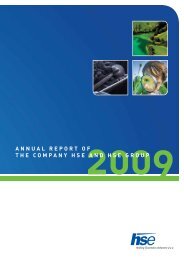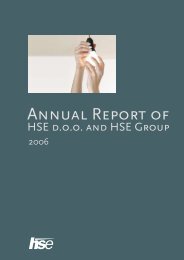Annual report - HSE
Annual report - HSE
Annual report - HSE
You also want an ePaper? Increase the reach of your titles
YUMPU automatically turns print PDFs into web optimized ePapers that Google loves.
4.5.7.7 Equity<br />
Total equity of the company represents its liability to owners which falls due if the<br />
company ceases to operate, whereby the amount of equity is adjusted with respect to the<br />
then attainable price for the company’s net assets. It is determined by both the amounts<br />
invested by owners and the amounts generated in the course of operation that belong to<br />
the owners. It is decreased by the loss incurred in the course of operations and increased<br />
by the profit in the period.<br />
Nominal capital and capital surplus represent owner’s cash contributions and contributions<br />
in kind.<br />
As at 31 December 2002, the general equity revaluation adjustments included the<br />
revaluation of share capital before 2002 in accordance with then applicable Slovene<br />
Accounting Standards. The adjustment due to the transfer to new Slovene Accounting<br />
Standards has been transferred to capital surplus. The amount can only be used for<br />
increase in share capital.<br />
Other reserves are purposely retained earnings from the previous years. They are created<br />
on the basis of the decision by relevant supervisory body or owner.<br />
Fair value reserve represents the revaluation amounts of individual categories of assets.<br />
Retained earnings include unallocated profit of the current year.<br />
4.5.7.8 Provisions for jubilee and termination benefits<br />
In accordance with legal regulations, collective agreement and internal rules, the company<br />
is obliged to pay jubilee benefits to employees and termination benefits on their retirement<br />
for which long-term provisions are created. There are no other existing pension liabilities.<br />
Provisions are created in the amount of estimated future payments for termination and<br />
jubilee benefits discounted at the end of the financial year. The calculation is prepared<br />
for each employee by taking into account the costs of termination benefits on retirement<br />
and costs of all expected jubilee benefits until retirement. The calculation with the use of<br />
projected unit is prepared by actuary. Payments for termination benefits on retirement and<br />
jubilee benefits decrease the created provisions.<br />
4.5.7.9 Other provisions<br />
Provisions are recognised when the company has a legal or constructive obligations arising<br />
from past event, which can be reliably assessed, and when it is likely that that an outflow of<br />
resources embodying economic benefits will be required to settle the liability.<br />
The amount of the provision must be equal to the present value of the expenditure<br />
expected to be required to settle the liability. Since provisions are intended for covering<br />
probable, but not certain obligations, the amount recognised as a provision is merely the<br />
best estimate of the expenditure needed for the settlement of obligation existing on the<br />
date of the statement of financial position. In reaching the best estimate of a provision, the<br />
risks and uncertainties that inevitably surround the events and circumstances are taken into<br />
account.<br />
Provisions are directly decreased by costs or expenses, for which they were created to<br />
cover. This means that in the financial year such costs or expenses do not appear in the<br />
profit or loss anymore.<br />
<strong>Annual</strong> Report <strong>HSE</strong> 2012<br />
4 Financial Report of the company <strong>HSE</strong><br />
124<br />
If the expected liabilities do not occur, the amount of created provisions is reversed and<br />
recognised under other operating revenue.<br />
4.5.7.10 Other assets and liabilities<br />
Other assets include short-term deferred costs and accrued revenue. Deferred costs<br />
represent the amounts incurred but not yet charged against the profit or loss. Accrued<br />
revenue is revenue that is taken into account in the profit or loss, although it has not been<br />
charged yet.<br />
Other liabilities include long-term and short-term accrued costs and deferred revenue.<br />
Accrued costs are amounts that have not occurred yet, but they will in the future and are<br />
already influencing the profit or loss.
















